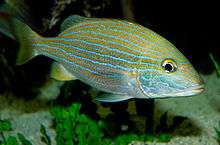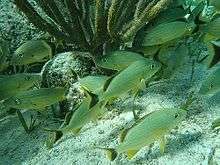Blue striped grunt
The blue striped grunt (Haemulon sciurus) or bluestriped grunt, is a subtropical species of grunt native to the western Atlantic Ocean.[1] It was described by the English naturalist George Shaw in 1803.
| Blue striped grunt | |
|---|---|
 | |
| Scientific classification | |
| Kingdom: | Animalia |
| Phylum: | Chordata |
| Class: | Actinopterygii |
| Order: | Perciformes |
| Family: | Haemulidae |
| Genus: | Haemulon |
| Species: | H. sciurus |
| Binomial name | |
| Haemulon sciurus (G. Shaw, 1803) | |
| Synonyms | |
| |
Its common name comes from its blue stripes and from its habit of grunting by grinding its pharyngeal teeth. The swim bladder, acting as a resonator, amplifies this sound.
Description
The blue striped grunt commonly grows to a length of 20 to 25 cm (8 to 10 inches), and its maximum recorded length is 46 cm (18 inches). The maximum reported age is 12 years. It can weigh up to 750 grams.
The head and the body are yellow with many narrow, horizontal blue stripes. The stripe under the eye has a characteristic arch. There is one yellow dorsal fin with 12 dorsal spines and 16-17 dorsal soft rays. The anal fin is dusky yellow. It has three anal spines and nine anal soft rays. The soft dorsal and caudal fins are blackish. The scales above the lateral line are enlarged, while the scales below are oblique.
Distribution and habitat
The blue striped grunt is found in mangroves, seagrass beds, dropoffs and coral reefs at depths up to 30 meters. Its range includes the Western Atlantic, Florida, Gulf of Mexico, and the Caribbean down to Brazil.
Behavior

The fish travels in schools with the smaller French grunt (H. flavolineatum), a close relative. Up to 1,000 grunts can form a school. The schools generally cruise near coral.
The diet consists mainly of shrimp. It may also eat annelids, bivalves, and crustaceans.
Predators of the grunt are larger piscivorous fish, such as sharks.
Human uses
The blue striped grunt is edible, and when caught, is marketed fresh. It is only of minor commercial importance, however. There have been reports of ciguatera poisoning from consumption of this fish.[1]
Blue striped grunts are also valued as a specimen for public aquariums.
References
- Froese, Rainer and Pauly, Daniel, eds. (2013). "Haemulon sciurus" in FishBase. August 2013 version.
| Wikimedia Commons has media related to Haemulon sciurus. |